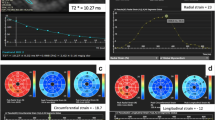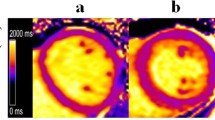Abstract
Cardiovascular Magnetic Resonance (CMR)-based T1 mapping and Heart Deformation Analysis (CMR-HDA) can assess the myocardial tissue characteristic and strain of cardiomyopathy. Whether they can assess cardiac abnormality of hypothyroidism (HT) is unknown. We aim to analysis left ventricular (LV) T1 values and strain of patients with overt HT (OHT) and subclinical HT (SHT) with CMR-based T1 mapping and HDA. This study prospectively included 32 OHT patients, 23 SHT patients and 27 healthy controls who underwent CMR. LV T1 mapping was obtained with a Modified Look-Locker Inversion Recovery sequence while LV circumferential strain (LVCS) and radial strain (LVRS), LV longitudinal strain (LVLS) were respectively analyzed on the short-axial and four-chamber cines with HDA. LV Eject Fraction among three groups were similar (p = 0.676). LV myocardial T1 correlated with LVCS (r = 0.734, p < 0.001) and LVRS (r = − 0.340, p = 0.011). LV myocardial T1 of OHT patients significantly increased in comparison with SHT patients (t = 5.403, p < 0.001) and normal controls (t = 10.197, p < 0.001), meanwhile, LV myocardial T1 of SHT patients were higher than that of controls (t = 2.629, p = 0.013). Compared with SHT patients (t = 1.925, p = 0.031) and normal controls (t = 2.875, p = 0.006), LVCS of OHT patients reduced while LVCS of SHT patients were lower than that of normal controls (t = 2.451, p = 0.020). LVRS of SHT patients were higher than OHT patients (t = 2.778, p = 0.008), but comparable to normal controls (t = 1.134, p = 0.266). LVLS of SHT and OHT significantly impaired in comparison with normal control. The increased LV myocardial T1 value and reduced strain were found in HT. CMR-based LV myocardial T1 and stain analysis are useful to evaluate myocardial tissue characteristic and mechanics in both overt and subclinical hypothyroidism.






Similar content being viewed by others
Abbreviations
- CMR:
-
Cardiovascular magnetic resonance
- HDA:
-
Heart deformation analysis
- HT:
-
Hypothyroidism
- OHT:
-
Overt hypothyroidism
- SHT:
-
Subclinical hypothyroidism
- LVCS:
-
Left ventricular circumferential strain
- LVRS:
-
Left ventricular radial strain
- LVLS:
-
Left ventricular longitudinal strain
- LVSS:
-
Left ventricular shear strain
- LVEF:
-
LV eject fraction
- TSH:
-
Thyroid-stimulating hormone
- FT4:
-
Free thyroxine
- FT3:
-
Free triiodothyronine
- Tg-Ab:
-
Antithyroglobulin
- TPO-Ab:
-
Antithyroid peroxidase antibody
- TE:
-
Echo time
- TR:
-
Repetition time
- MOLLI:
-
Modified look-locker inversion recovery
- SSFP:
-
Steady state free precession
- ESV:
-
End diastolic volume
- EDV:
-
End systolic volume
- SV:
-
Stroke volume
- ECV:
-
Extracellular volume fraction
References
Cooper DS (2001) Clinical practice. Subclinical hypothyroidism. N Engl J Med 345:260–265
Danzi S, Klein I (2012) Thyroid hormone and the cardiovascular system. Med Clin North Am 96:257–268
Liu Y, Redetzke RA, Said S, Pottala JV, de Escobar GM, Gerdes AM (2008) Serum thyroid hormone levels may not accurately reflect thyroid tissue levels and cardiac function in mild hypothyroidism. Am J Physiol Heart Circ Physiol 294:H2137–H2143
Sunbul M, Durmus E, Kivrak T, Yildiz H, Kanar BG, Ozben B et al (2013) Left ventricular strain and strain rate by two dimensional speckle tracking echocardiographyin patients with subclinical hypothyroidism. Eur Rev Med Pharmacol Sci 17:3323–3328
Tadic M, Ilic S, Kostic N, Caparevic Z, Celic V (2014) Subclinical hypothyroidism and left ventricular mechanics: a three-dimensional speckle tracking study. J Clin Endocrinol Metab 99:307–314
Chitiboi T, Axel L (2017) Magnetic resonance imaging of myocardial strain: a review of current approaches. J Magn Reson Imaging 46:1263–1280
Lin K, Collins J, Chowdhary V, Markl M, Carr JC (2016) Heart deformation analysis: measuring regional myocardial velocity with MR imaging. Int J Cardiovasc Imaging 32:1103–1111
Canepa M, Pozios I, Vianello PF, Ameri P, Brunelli C, Ferrucci L et al (2016) Distinguishing ventricular septal bulge versus hypertrophic cardiomyopathy in the elderly. 102:1087–1094
Diao KY, Yang ZG, Xu HY, Liu X, Zhang Q, Shi K et al (2016) Histologic validation of myocardial fibrosis measured by T1 mapping: a systematic review and meta-analysis. J Cardiovasc Magn Reson 18:92
Gao X, Liu M, Qu A, Chen Z, Jia Y, Yang N et al (2016) Native magnetic resonance T1-mapping identifies diffuse myocardial injury in hypothyroidism. PLoS ONE 11:e0151266
Yao Z, Gao X, Liu M, Chen Z, Yang N, Jia YM et al (2018) Diffuse myocardial injuries are present in subclinical hypothyroidism: a clinical study using myocardial T1-mapping quantification. Sci Rep 8:4999
Everts ME, Verhoeven FA, Bezstarosti K, Moerings EP, Hennemann G, Visser TJ et al (1996) Uptake of thyroid hormones in neonatal rat cardiac myocytes. Endocrinology 137:4235–4242
Brenta G, Mutti LA, Schnitman M, Fretes O, Perrone A, Matute ML (2003) Assessment of left ventricular diastolic function by radionuclide ventriculography at rest and exercise in subclinical hypothyroidism, and its response to L-thyroxine therapy. Am J Cardiol 91:1327–1330
Claus P, Omar AMS, Pedrizzetti G, Sengupta PP, Nagel E (2015) Tissue tracking technology for assessing cardiac mechanics: principles, normal values, and clinical applications. JACC Cardiovasc Imaging 8:1444–1460
Xie Q, Li H, Li C, Bai W, Li C, Peng Y et al (2014) Assessment of left ventricular global systolic function using real-time three-dimensional speckle-tracking echocardiography in patients with hypothyroidism. Sheng Wu Yi Xue Gong Cheng Xue Za Zhi 31:58–63
Lin K, Collins JD, Chowdhary V, Markl M, Carr JC (2016) Heart deformation analysis for automated quantification of cardiac function and regional myocardial motion patterns: a proof of concept study in patients with cardiomyopathy and healthy subjects. Eur J Radiol 85:1811–1817
Wiig H, Reed RK, Tenstad O (2000) Interstitial fluid pressure, composition of interstitium, and interstitial exclusion of albumin in hypothyroid rats. Am J Physiol Heart Circ Physiol 278:H1627–H1639
Ferreira VM, Piechnik SK, Dall’Armellina E, Karamitsos TD, Francis JM, Choudhury RP et al (2012) Non-contrast T1-mapping detects acute myocardial edema with high diagnostic accuracy: a comparison to T2-weighted cardiovascular magnetic resonance. J Cardiovasc Magn Reson 14:42
Perea RJ, Ortiz-Perez JT, Sole M, Cibeira MT, de Caralt TM, Prat-Gonzalez S et al (2015) T1 mapping: characterisation of myocardial interstitial space. Insights Imaging 6:189–202
Graham-Brown MP, March DS, Churchward DR, Stensel DJ, Singh A, Arnold R et al (2016) Novel cardiac nuclear magnetic resonance method for noninvasive assessment of myocardial fibrosis in hemodialysis patients. Kidney Int 90:835–844
Homsi R, Luetkens JA, Skowasch D, Pizarro C, Sprinkart AM, Gieseke J et al (2017) Left ventricular myocardial fibrosis, atrophy, and impaired contractility in patients with pulmonary arterial hypertension and a preserved left ventricular function: a cardiac magnetic resonance study. J Thorac Imaging 32:36–42
Acknowledgements
This research is supported by Beijing Natural Science Foundation (7182149) and National Natural Science Foundation of China (81871328).
Author information
Authors and Affiliations
Corresponding author
Ethics declarations
Conflict of interest
The authors declare that they have no conflict of interest.
Ethical approval
All procedures performed in studies involving human participants were in accordance with the ethical standards of the institutional and/or national research committee and with the 1964 Helsinki declaration and its later amendments or comparable ethical standards.
Informed consent
Informed consent was obtained from all individual participants included in the study.
Rights and permissions
About this article
Cite this article
Liu, M., Liu, W., Zhang, P. et al. Left ventricular myocardial T1 mapping and strain analysis evaluate cardiac abnormality in hypothyroidism. Int J Cardiovasc Imaging 35, 507–515 (2019). https://doi.org/10.1007/s10554-018-1456-4
Received:
Accepted:
Published:
Issue Date:
DOI: https://doi.org/10.1007/s10554-018-1456-4




